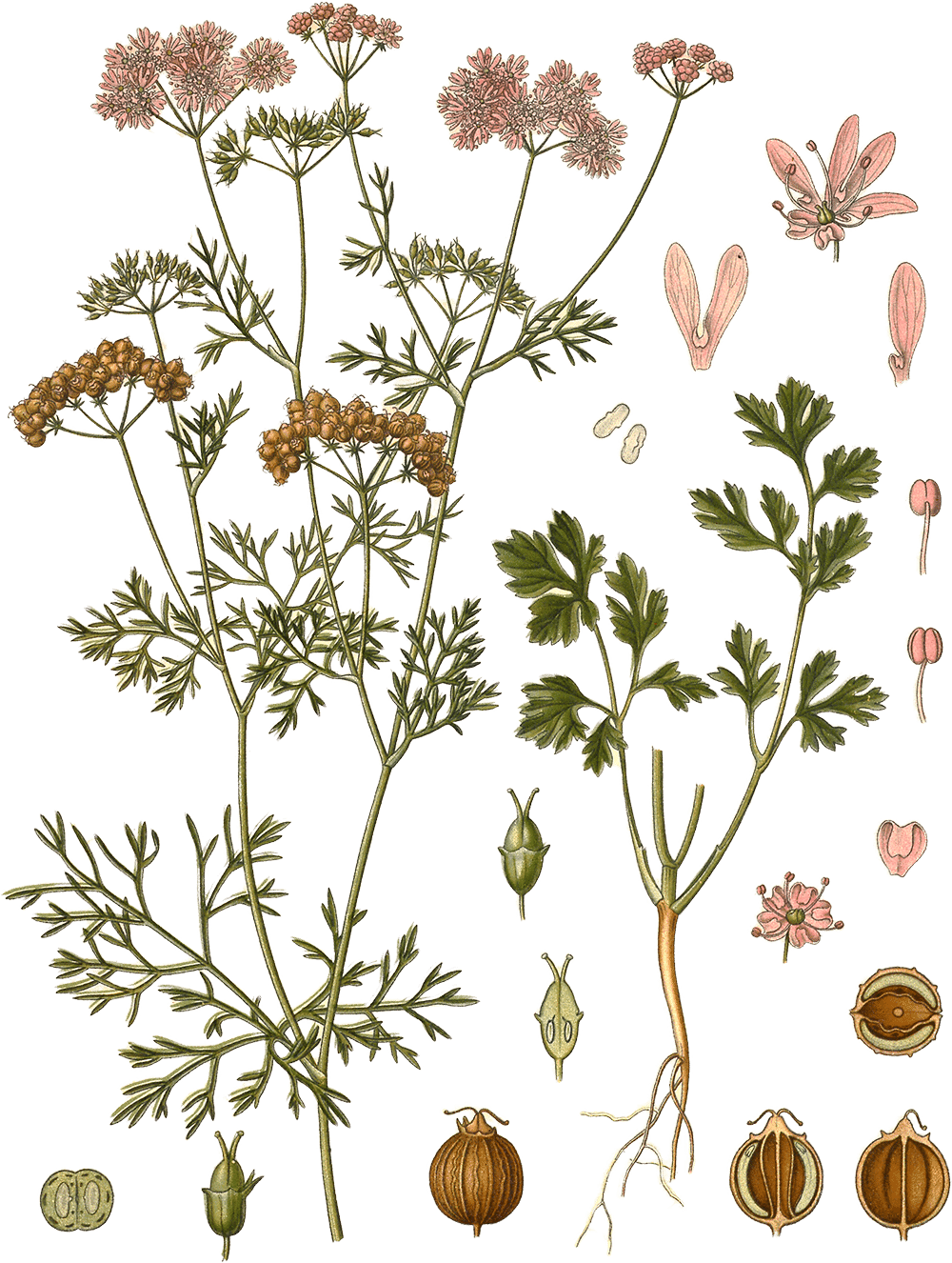Coriander #

Illustration of Coriandrum sativum L. from Köhler's Medizinal-Pflanzen (1887)
Coriander (Coriandrum sativum L.) is a culinary spice and herb from the Apiaceae family,1 originating in the region(s) of Mediterranean; W. Asia; India; SW As.2 It is used for its fruit and leaf, primarily for curries; anti-microbial. Its aroma is described as warm, aromatic, sweet, with a heat index of 1.3
| English | Arabic | Chinese | Hungarian |
|---|---|---|---|
| coriander | كزبرة | 芫荽 | koriander |
Overview #
| id | coriander |
|---|---|
| species name | Coriandrum sativum L. |
| family | Apiaceae |
| part used | fruit; leaf |
| macroarea | Asia |
| region of origin | Mediterranean; W. Asia; India; SW As |
| cultivation | Argentina; India; Morocco; Romania; Spain; Yugoslavia |
| color | light yellow |
| botanical database | POWO |
Etymologies #
English coriander < Old French coriandre < Latin coriandrum < Ancient Greek korīannon;-dron
Arabic كزبرة kuzbara ‘coriander’ < Aramaic kusbara ‘coriander’; cf. cognates Classical Syriac kūsbartā < Akkadian kisibirru ‘coriander’ < Sanskrit कुस्तुम्बरी kustumbarī ‘coriander’; cf. Tamil kottamalli; Indonesian ketumbar
Mandarin Chinese 芫荽 yánsuī ‘coriander’ [lilac-coriander ], yan ’lilac daphne’ + sui ‘coriander’, maybe a remodeling of 胡荽 husui after 芫花 yanhua ’lilac daphne’ (Daphne genkwa a herb in TCM, on accou (the characters only appear in these words), ca. 1592
Mandarin Chinese 胡荽 húsuī ‘coriander’ [barbarian-sui ], phono-semantic matching of an Iranian form < Iranian * *koswi, *košwi, gošwi ‘id.’; cf. cognates Middle Persian gišnīz/kišnīz ‘coriander’ ; Modern Persian گشنیز gešniz ‘id.’
Names #
English #
| term | source |
|---|---|
| coriander | OED |
| Chinese parsley | OED |
| coriander-seed | OED |
| cilantro | OED |
| dhania | OED |
| coliander | OED |
Arabic #
| script | term | literal | source |
|---|---|---|---|
| كزبرة | kuzbara | Wehr, 1976 |
Chinese #
| script | term | literal | source |
|---|---|---|---|
| 芫荽 | yánsuī | lilac-coriander | MDBG |
| 芫茜 | yánqiàn | lilac-madder | Wikipedia |
| 香茜 | xiāngqiàn | fragrant-madder | Wikipedia |
| 香菜 | xiāngcài | fragrant-vegetable | MDBG |
| 胡荽 | húsuī | barbarian-coriander | Defrancis, 2003 |
POWO. (2022). Plants of the World Online (Botanical Database). Facilitated by the Royal Botanic Gardens, Kew. http://www.plantsoftheworldonline.org/ ↩︎
van Wyk, B.-E. (2014). Culinary Herbs and Spices of the World. University of Chicago Press, joint publication with the Royal Botanic Gardens, Kew. https://doi.org/10.7208/chicago/9780226091839.001.0001 ↩︎
Medicinal Spices Exhibit. (2002). UCLA Biomedical Library: History & Special Collections. https://unitproj.library.ucla.edu/biomed/spice/index.cfm?spicefilename=taste.txt&itemsuppress=yes&displayswitch=0 ↩︎